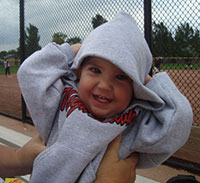Our medical and scientific team at West Coast Fertility Centers has conducted very promising research leading to a patent pending method of egg freezing called the LANDA Freezing Technology which has reported a much higher frozen egg pregnancy rate compared to other published data.
Our LANDA Technology for egg freezing and thawing (cryopreservation) has resulted in the births of 60 healthy babies as of early March 2011. This number is among the highest in the nation from a single fertility clinic and also includes high numbers of ongoing pregnancies from the use of frozen eggs.
To understand the entire process of egg freezing, we take you on a journey of understanding…

A Brief History of Egg Freezing
To best understand the current status of egg freezing it is helpful to view the historical evolution of In-Vitro Fertilization (IVF) which, in 1978, resulted in the birth of Louise Brown, the first human conceived in the laboratory. In IVF, eggs are harvested from the woman’s ovaries after priming their growth with specific hormone medications. The harvested eggs are inseminated and become embryos in the lab within three days.
A limited number of embryos are then transferred to the uterus, potentially leaving a surplus, which is usually frozen for a future transfer if the first try is unsuccessful. However, if pregnancy occurs during the first attempt, embryo disposition can be problematic due to conflicting opinions about their status in society.
Clearly, a potential solution to this dilemma is to inseminate a limited number of eggs after harvest and freeze the unfertilized eggs until needed in the future. Unlike an embryo, the egg is a single unfertilized cell, which in some groups simpler to discard when no longer needed.
The Egg Freezing Process
Early trials of egg freezing used suboptimal freeze/thaw protocols did not address the structural differences between oocytes (eggs) and embryos. The intent of most freezing protocols is to achieve simultaneous exchange of intracellular water with protective solutions in a limited amount of time, under special lab conditions, without causing injury to the target tissue.
Since the human egg is the largest cell in the body and is composed mostly of water, the formation of ice during freezing can disrupt the egg’s internal microscopic contents and its outer membrane. Therefore cryoprotectants, which act as “antifreeze solution” are used to dehydrate the water and replace it with the protective solution to reduce internal ice formation.
However, the dilemma is that these cryoprotectants tend to be cytotoxic and, as such, they may damage the egg if exposure is too long at “high” temperatures (4 to 37 degrees Celsius). So the science of egg freezing (cryobiology) is all about compromise: how to remove water as quickly as possible, without damaging the egg.
The Egg Thawing Process
The science team at West Coast Fertility Centers noticed that equally important to a successful freezing program is the development of a robust thaw protocol that ensures the survival of the egg when ready to be fertilized. Cell death can occur if conditions are not optimal during the reanimation sequence.

The SUCCESSFUL Status of Egg Freezing at West Coaster Fertility Centers
Previously, the low success described in early published medical articles seemed to perpetuate the false notion that egg freezing would never become a reality. Building on our high success rate with embryo freezing, our focus turned to the systematic analysis of the anatomy and the fluid composition of a human oocyte and its special requirements needed to survive the rigors of very low freezing temperature and still maintain its integrity.
Our medical and scientific team at West Coast Fertility Centers has conducted very promising research leading to a patent pending method of egg freezing called the LANDA Freezing Technology which has reported a much higher frozen egg pregnancy rate compared to other published data.
Our LANDA Technology for egg freezing and thawing (cryopreservation) has resulted in the births of 60 healthy babies as of early March 2011. This number is among the highest in the nation from a single fertility clinic and also includes high numbers of ongoing pregnancies from the use of frozen eggs.
Meet some of our Frozen Egg Babies



Due to increasing demand for egg freezing services, West Coast Fertility has formed a network of selected fertility centers to provide our freezing technology throughout the United States. After meeting strict criteria, each fertility center is awarded a license agreement entitling them to use our egg freezing method.





